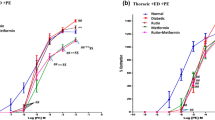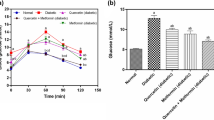Abstract
The study has been designed to investigate the effect of benfotiamine and fenofibrate in diabetes-induced experimental vascular endothelial dysfunction (VED) and nephropathy. The single administration of streptozotocin (STZ) (50 mg/kg, i.p.) produced diabetes, which was noted to develop VED and nephropathy in 8 weeks. The diabetes produced VED by attenuating acetylcholine-induced endothelium dependent relaxation, impairing the integrity of vascular endothelium, decreasing serum nitrite/nitrate concentration and increasing serum TBARS and aortic superoxide anion generation. Further, diabetes altered the lipid profile by increasing the serum cholesterol, triglycerides and decreasing the high density lipoprotein. The nephropathy was noted to be developed in the diabetic rat that was assessed in terms of increase in serum creatinine, blood urea, proteinuria, and glomerular damage. The benfotiamine (70 mg/kg, p.o.) and fenofibrate (32 mg/kg, p.o.) or lisinopril (1 mg/kg, p.o., a standard agent) treatments were started in diabetic rats after 1 week of STZ administration and continued for 7 weeks. The treatment with benfotiamine and fenofibrate either alone or in combination attenuated diabetes-induced VED and nephropathy. In addition, the combination of benfotiamine and fenofibrate was noted to be more effective in attenuating the diabetes-induced VED and nephropathy when compared to treatment with either drug alone or lisinopril. Treatment with fenofibrate normalizes the altered lipid profile in diabetic rats, whereas benfotiamine treatment has no effect on lipid alteration in diabetic rats. It may be concluded that diabetes-induced oxidative stress, lipids alteration, and consequent development of VED may be responsible for the induction of nephropathy in diabetic rats. Concurrent administration of benfotiamine and fenofibrate may provide synergistic benefits in preventing the development of diabetes-induced nephropathy by reducing the oxidative stress and lipid alteration, preventing the VED and subsequently improving the renal function.










Similar content being viewed by others
References
Ritz E, Orth SR (1999) Nephropathy in patients with type 2 diabetes mellitus. N Engl J Med 341:1127–1133. doi:10.1056/NEJM199910073411506
De Vriese AS, Verbeuren TJ, De Voorde JV et al (2000) Endothelial dysfunction in diabetes. Br J Pharmacol 130:963–974. doi:10.1038/sj.bjp.0703393
Escandon JC, Cipolla M (2001) Diabetes and endothelial dysfunction: a clinical perspective. Endocr Rev 22:36–52. doi:10.1210/er.22.1.36
Balakumar P, Koladiya RU, Ramasamy S et al (2008) Pharmacological interventions to prevent vascular endothelial dysfunction: future directions. J Health Sci 54:1–16. doi:10.1248/jhs.54.1
Heitzer T, Schlinzig T, Krohn K et al (2001) Endothelial dysfunction, oxidative stress, and risk of cardiovascular events in patients with coronary artery disease. Circulation 104:2673–2703. doi:10.1161/hc4601.099485
Laursen JB, Boesgaard S, Trautner S et al (2001) Endothelium-dependent vasorelaxation is inhibited by in vivo depletion of vascular thiol levels: role of endothelial nitric oxide synthase. Free Radic Res 35:387–394. doi:10.1080/10715760100300901
Ulker S, McKeown P, Bayraktutan U (2003) Vitamins reverse endothelial dysfunction through regulation of eNOS and NADPH oxidase activities. Hypertension 41:534–541. doi:10.1161/01.HYP.0000057421.28533.37
Balakumar P, Kaur T, Singh M (2008) Potential target sites to modulate vascular endothelial dysfunction: current perspectives and future directions. Toxicology 245:49–64. doi:10.1016/j.tox.2007.12.011
Hink U, Li H, Mollnau H et al (2001) Mechanisms underlying endothelial dysfunction in diabetes mellitus. Circ Res 88:e14–e22
Kathryn CB, Chow WS, Victor HG et al (2002) Advanced glycation end products and endothelial dysfunction in type 2 diabetes. Diabetes Care 25:1055–1059. doi:10.2337/diacare.25.6.1055
Thorand B, Baumert J, Chambless L et al (2006) Elevated markers of endothelial dysfunction predict type 2 diabetes mellitus in middle-aged men and women from the general population. Arterioscler Thromb Vasc Biol 26:398–412. doi:10.1161/01.ATV.0000198392.05307.aa
Nakagawa T, Sato W, Glushakova W et al (2007) Diabetic endothelial nitric oxide synthase knockout mice develop advanced diabetic nephropathy. J Am Soc Nephrol 18:539–550. doi:10.1681/ASN.2006050459
Prabhakar S, Starnes J, Shi S et al (2007) Diabetic nephropathy is associated with oxidative stress and decreased renal nitric oxide production. J Am Soc Nephrol 18:2945–2952. doi:10.1681/ASN.2006080895
Nakagami H, Kaneda Y, Ogihara T et al (2005) Endothelial dysfunction in hyperglycemia as a trigger of atherosclerosis. Curr Diabetes Rev 1:59–63. doi:10.2174/1573399052952550
Song Y, Maanson JE, Tinker L et al (2007) Circulating levels of endothelial adhesion molecules and risk of diabetes in an ethnically diverse cohort of women. Diabetes 56:1898–1904. doi:10.2337/db07-0250
Balakumar P, Chakkarwar VA, Krishan P et al (2008) Vascular endothelial dysfunction: a tug of war in diabetic nephropathy? Biomed Pharmacother. doi:10.1016/j.biopha.2008.08.008
Nakagami H, Morishita R, Yamamoto K et al (2001) Phosphorylation of p38 mitogen-activated protein kinase downstream of bax-caspase-3 pathway leads to cell death induced by high D-glucose in human endothelial cells. Diabetes 50:1472–1481. doi:10.2337/diabetes.50.6.1472
Zhao HJ, Wang S, Cheng H et al (2006) Endothelial nitric oxide synthase deficiency produces accelerated nephropathy in diabetic mice. J Am Soc Nephrol 17:2664–2669. doi:10.1681/ASN.2006070798
Futrakul N, Panichakul T, Sirisinha S et al (2004) Glomerular endothelial dysfunction in chronic kidney disease. Ren Fail 26:259–264. doi:10.1081/JDI-120039524
Shah DI, Singh M (2006) Involvement of Rho-kinase in experimental vascular endothelial dysfunction. Mol Cell Biochem 283:191–199. doi:10.1007/s11010-006-2679-6
Gojo A, Utsunomiya K, Taniguchi K et al (2007) The Rho-kinase inhibitor, fasudil, attenuates diabetic nephropathy in streptozotocin-induced diabetic rats. Eur J Pharmacol 568:242–247. doi:10.1016/j.ejphar.2007.04.011
Brownlee M (2001) Biochemistry and molecular cell biology of diabetic complications. Nature 414:813–820. doi:10.1038/414813a
Stirban A, Negrean M, Stratmann B et al (2006) Benfotiamine prevents macro and microvascular endothelial dysfunction and oxidative stress following a meal rich in advanced glycation end products in individuals with type 2 diabetes. Diabetes 29:2064–2071. doi:10.2337/dc06-0531
Babaei-Jadidi R, Karachalias N, Ahmed N et al (2003) Prevention of incipient diabetic nephropathy by high-dose thiamine and benfotiamine. Diabetes 52:2110–2120. doi:10.2337/diabetes.52.8.2110
Marchetti V, Menghini R, Rizzal S et al (2006) Benfotiamine counteracts glucose toxicity effects on endothelial progenitor cell differentiation via Akt/Foxo signaling. Diabetes 55:2231–2237. doi:10.2337/db06-0369
Wang Z, Jiang T, Li J et al (2005) Regulation of renal lipid metabolism, lipid accumulation, and glomerulosclerosis in FVB db/db mice with type 2 diabetes. Diabetes 54:2328–2335. doi:10.2337/diabetes.54.8.2328
Molitch ME (2006) Management of dyslipidemias in patients with diabetes and chronic kidney disease. Clin J Am Soc Nephrol 1:1090–1099. doi:10.2215/CJN.00780306
Balakumar P, Rose M, Ganti SS et al (2007) PPAR dual agonists: are they opening pandora’s box? Pharmacol Res 56:91–98. doi:10.1016/j.phrs.2007.03.002
Yang TL, Chen MF, Xia X et al (2004) Effect of fenofibrate on LDL-induced endothelial dysfunction in rats. Naunyn Schmiedebergs Arch Pharmacol 370:79–83
Yang TL, Chen MF, Xia X (2005) Effect of fenofibrate on the level of asymmetric dimethylarginine in individuals with hypertriglyceridemia. Eur J Clin Pharmacol 62:179–184. doi:10.1007/s00228-005-0095-6
Chen LL, Zhang JY, Wang BP (2006) Renoprotective effects of fenofibrate in diabetic rats are achieved by suppressing kidney plasminogen activator inhibitor-1. Vascul Pharmacol 44:309–315. doi:10.1016/j.vph.2006.01.004
Trinder K, Hiraga Y, Nakamura N et al (1979) Determination of glucose in blood using glucose oxidase-peroxidase system and 8-hydroxyquinoline-p-anisidine. Chem Pharm Bull (Tokyo) 27:568–570
Allain CC, Poon LS, Chan CS et al (1974) Enzymatic determination of total serum cholesterol. Clin Chem 20:470
Werner M, Gabrielson DJ, Eastman J (1981) Ultramicro determination of serum triglycerides by bioluminescent assay. Clin Chem 27:268–271
Jindal S, Singh S, Balakumar P (2008) Effect of bis (maltolato) oxovanadium (BMOV) in uric acid and sodium arsenite-induced vascular endothelial dysfunction in rats. Int J Cardiol 128:383–391. doi:10.1016/j.ijcard.2007.05.031
Malczak HT, Buck RC (1997) Regeneration of endothelium in rat aorta after local freezing. A scanning electron microscopic study. Am J Pathol 86:133–148
Lai JCK, Tranfield EM, Walker DC et al (2003) Ultrastructural evidence of early endothelial damage in coronary arteries of rat cardiac allografts. J Heart Lung Transplant 22:993–1001. doi:10.1016/S1053-2498(02)01163-4
Greenwald I, Gross J (1924) The chemistry jaffe’s reaction for creatinine. A red tautomer of creatinine picrate. Biol Chem 59:601–612
Fawcett JK, Scott E (1960) A rapid and precise method for the determination of urea. J Clin Pathol 13:156–159. doi:10.1136/jcp.13.2.156
Watanabe N, Kame S, Ohkubo A et al (1986) Urinary protein as measured with a pyrogallol red-molybdate complex manually and in a hitachi 726 automated analyzer. Clin Chem 32:1551–1554
Cha DR, Kang YS, Han SY et al (2004) Vascular endothelial growth factor is increased during early stage of diabetic nephropathy in type II diabetic rats. J Endocrinol 183:183–194. doi:10.1677/joe.1.05647
Tomohiro T, Kumai T, Sato T et al (2007) Hypertension aggravates glomerular dysfunction with oxidative stress in a rat model of diabetic nephropathy. Life Sci 80:1364–1372. doi:10.1016/j.lfs.2006.11.054
Alderson NL, Chachich ME, Frizzel N et al (2004) Effect of antioxidants and ACE inhibition on chemical modification of proteins and progression of nephropathy in the streptozotocin diabetic rat. Diabetologia 47:1385–1395. doi:10.1007/s00125-004-1474-8
Shah DI, Singh M (2006) Effect of fasudil on macrovascular disorder-induced endothelial dysfunction. Can J Physiol Pharmacol 84:835–845. doi:10.1139/Y06-036
Gadau S, Emanueli C, Linthout S et al (2006) Benfotiamine accelerates the healing of ischemia diabetic limbs in mice through protein kinase B/Akt-mediated potentiation of angiogenesis and inhibition of apoptosis. Diabetologia 49:405–420. doi:10.1007/s00125-005-0103-5
De Sotomayor MA, Mingorance C, Andriantsitohaina R (2007) Fenofibrate improves age-related endothelial dysfunction in rat resistance arteries. Atherosclerosis 193:112–120. doi:10.1016/j.atherosclerosis.2006.08.041
Cooke JP (2000) Does ADMA Cause endothelial dysfunction? Arterioscler Thromb Vasc Biol 20:2032–2037
Flanders KC, Burmester JK (2003) Medical applications of transforming growth factor-beta. Clin Med Res 1:13–20
Nicholas SB, Aguiniga E, Ren Y et al (2005) Plasminogen activator inhibitor-1 deficiency retards diabetic nephropathy. Kidney Int 67:1297–1307. doi:10.1111/j.1523-1755.2005.00207.x
Paueksakon P, Revelo MP, Ma LJ et al (2002) Microangiopathic injury and augmented PAI-1 in human diabetic nephropathy. Kidney Int 61:2142–2148. doi:10.1046/j.1523-1755.2002.00384.x
Hirano T, Kashiwazaki K, Moritomo Y et al (1997) Albuminuria is directly associated with increased plasma PAI-1 and factor VII levels in NIDDM patients. Diabetes Res Clin Pract 36:11–18. doi:10.1016/S0168-8227(97)01384-3
Eddy AA (2002) Plasminogen activator inhibitor-1 and the kidney. Am J Physiol Renal Physiol 283:F209–F220
Taskinen MR (1990) Hyperlipidaemia in diabetes. Baillieres Clin Endocrinol Metab 4:743–775. doi:10.1016/S0950-351X(05)80078-3
Sevak AR, Goyal RK (1996) Effects of chronic treatment with lisinopril on cardiovascular complications in streptozotocin diabetic and DOCA hypertensive rats. Pharmacol Res 34:201–209. doi:10.1006/phrs.1996.0089
Trevisan R, Dodesini AR, Lepore G (2006) Lipids and renal disease. J Am Soc Nephrol 17:S145–S147. doi:10.1681/ASN.2005121320
Vaziri ND, Sato T, Liang K (2003) Molecular mechanism of altered cholesterol metabolism in focal glomerulosclerosis. Kidney Int 63:1756–1763. doi:10.1046/j.1523-1755.2003.00911.x
Butler R, Morris AD, Struthers AD (2001) Lisinopril improves endothelial function in chronic cigarette smokers. Clin Sci 101:53–58. doi:10.1042/CS20010070
Amann B, Tinzmann R, Angelkort B (2003) ACE inhibitors improve diabetic nephropathy through suppression of renal MCP-1. Diabetes 26:2421–2425. doi:10.2337/diacare.26.8.2421
Benigni A, Zoja C, Corna D et al (2003) Add-on anti-TGF-β antibody to ACE inhibitor arrests progressive diabetic nephropathy in the rat. J Am Soc Nephrol 14:1816–1824. doi:10.1097/01.ASN.0000074238.61967.B7
Acknowledgment
We wish to express our gratitude to Shri. Parveen Garg Ji, Honorable Chairman, ISF College of Pharmacy, Moga, Punjab, India for his inspiration and constant support.
Author information
Authors and Affiliations
Corresponding author
Rights and permissions
About this article
Cite this article
Balakumar, P., Chakkarwar, V.A. & Singh, M. Ameliorative effect of combination of benfotiamine and fenofibrate in diabetes-induced vascular endothelial dysfunction and nephropathy in the rat. Mol Cell Biochem 320, 149–162 (2009). https://doi.org/10.1007/s11010-008-9917-z
Received:
Accepted:
Published:
Issue Date:
DOI: https://doi.org/10.1007/s11010-008-9917-z




